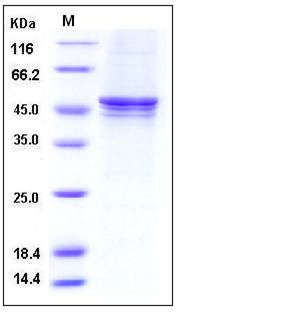Human GSK3B Protein (His Tag)
GSK3B
- 100ug (NPP3912) Please inquiry
| Catalog Number | P10044-H07B |
|---|---|
| Organism Species | Human |
| Host | Baculovirus-Insect Cells |
| Synonyms | GSK3B |
| Molecular Weight | The recombinant human GSK3B consists of 452 amino acids and predicts a molecular mass of 50.4 kDa. The apparent molecular mass of rhGSK3B is approximately 44-48 kDa in SDS-PAGE under reducing conditions. |
| predicted N | Met |
| SDS-PAGE |  |
| Purity | > 90 % as determined by SDS-PAGE |
| Protein Construction | The amino acids corresponding to the full length of human GSK3B isoform 1 (NP_002084.2) (Met 1-Thr 433) was fused with a polyhistidine tag at the N-terminus. |
| Bio-activity | 1. The specific activity was determined to be 45 nmol/min/mg using synthetic Phospho-Glycogen Synthase Peptide-2 (YRRAAVPPSPSLSRHSSPHQpSEDEEE) as substrate. 2. Immobilized His-GSK3B at 10 μg/ml (100 μl/well) can bind biotinylated human HG3C-CTNNB1 (cat:11279-H20B), EC50 of biotinylated human HG3C-CTNNB1 (cat:11279-H20B) is 0.15-0.35 μg/ml. |
| Research Area | Developmental Biology |Metabolism |Pathways and Processes |Metabolic signaling pathways |Energy transfer pathways |Integration of energy | |
| Formulation | Supplied as sterile 20mM Tris, 500mM NaCl, pH 7.4, 25% glycerol, 0.5mM PMSF, 0.5mM EDTA 1. Normally 5 % - 8 % trehalose, mannitol and 0.01% Tween80 are added as protectants before lyophilization. Specific concentrations are included in the hardcopy of COA. |
| Background | GSK3B is a serine-threonine kinase, belonging to the glycogen synthase kinase subfamily. It Contains 1 protein kinase domain, and is expressed in testis, thymus, prostate and ovary and weakly expressed in lung, brain and kidney. GSK3B is involved in energy metabolism, neuronal cell development, and body pattern formation. Polymorphisms in GSK3B gene have been implicated in modifying risk of Parkinson disease, and studies in mice show that overexpression of this gene may be relevant to the pathogenesis of Alzheimer disease. GSK3B participates in the Wnt signaling pathway. It is implicated in the hormonal control of several regulatory proteins including glycogen synthase, MYB and the transcription factor JUN. Phosphorylates JUN at sites proximal to its DNA-binding domain, thereby reducing its affinity for DNA. Phosphorylates MUC1 in breast cancer cells, and decreases the interaction of MUC1 with CTNNB1/beta-catenin. GSK3B also plays an important role in ERBB2-dependent stabilization of microtubules at the cell cortex. It prevents the phosphorylation of APC and CLASP2, allowing its association with the cell membrane. In turn, membrane-bound APC allows the localization of MACF1 to the cell membrane, which is required for microtubule capture and stabilization. GSK3B phosphorylates MACF1 and this phosphorylation inhibits the binding of MACF1 to microtubules which is critical for its role in bulge stem cell migration and skin wound repair. It may be required for early embryo development and neuron differentiation. |
| Reference |
